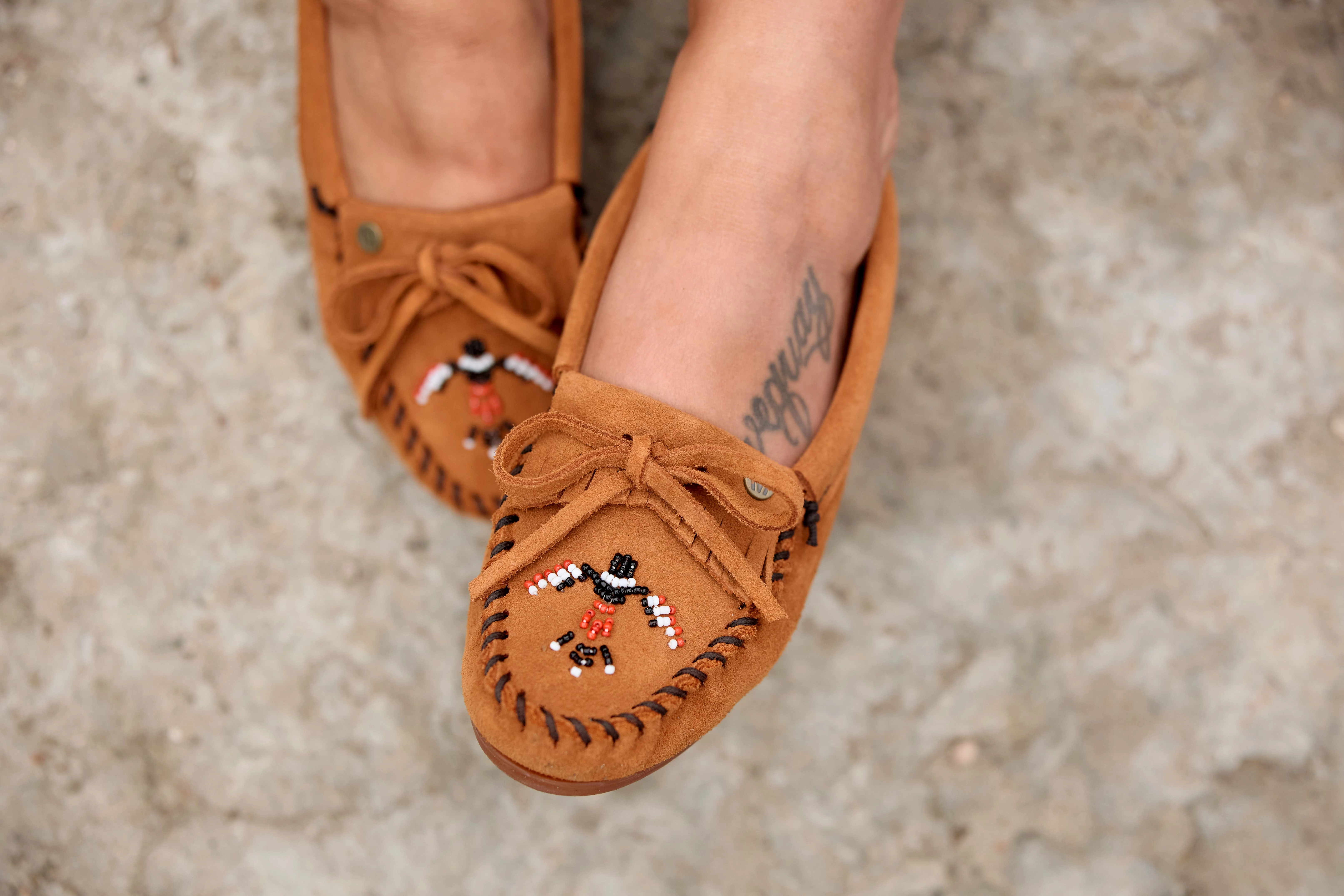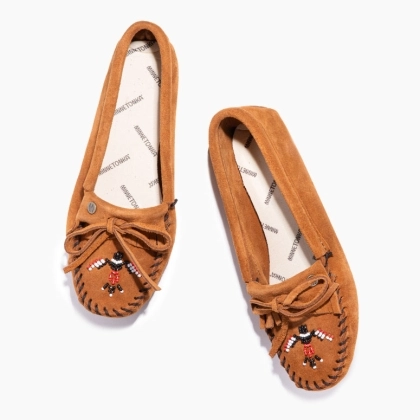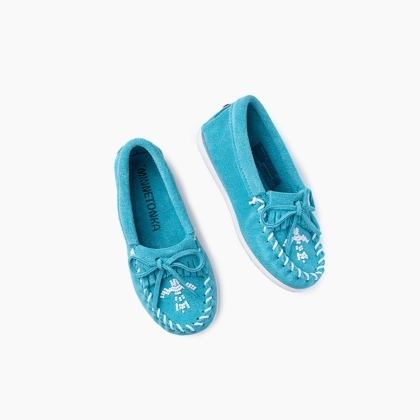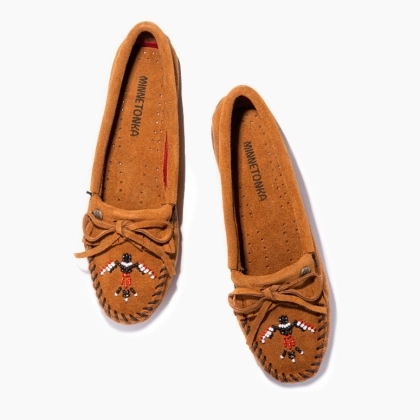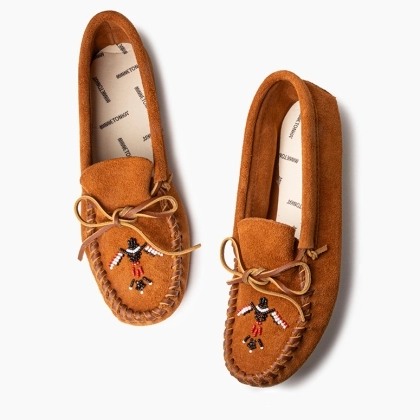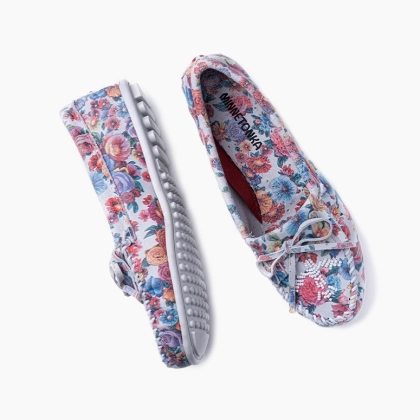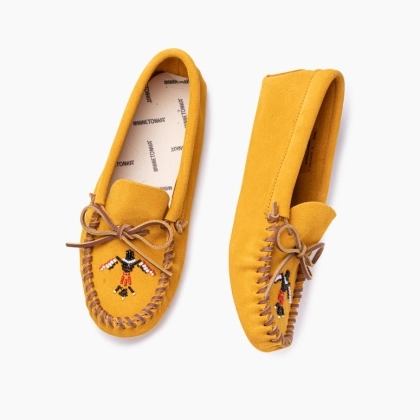Redesigned by a Native American Artist: Minnetonka x Lucie Skjefte — Thunderbird "Animikii"
We were so excited to work with Red Lake Nation Anishinaabe designer, Lucie Skjefte – who designed the beading on the Ziigwan Waabigwan and Ayashe Mocs – to redesign the beading for the Thunderbird collection. The NEW Thunderbird “Animikii” pays homage to Lucie’s heritage and her son, Animikii.
In the interview below, Lucie gives us more insight into the meaning and inspiration behind this momentous redesign.
When asked to help rename the Thunderbird relaunch collection, you chose the Ojibwemowin word “Animikii." What does “Animikii” mean? Both to the Anishinaabe culture and to you personally?
The word “Animikii” [pronounced ah-nih-mih-kee] means “Thunderbird" in Ojibwemowin, the language of the Anishinaabe people.
In Native American culture, the Thunderbird symbolizes strength and spirituality that’s closely connected to nature. According to Ojibwe legend, Thunderbirds hold the power to create the booming sounds of thunder and lightning, purify bodies of water, and ignite fires that foster new growth. They are a sacred symbol to the Anishinaabe way of life.
My personal connection to the Thunderbird is expressed through the name of my son, Animikii – a name which was gifted to him from my niiyawen’enh, (my namesake) Amik O’Gaabaw (Larry Smallwood).
My son was named ‘Thunderbird’ as a testament to his strength – from the moment of his conception through his birth, the radiance he exudes, and the many manidoog (spirits) that surround and watch over him.
Upon meeting my son, an elder from my reservation (Red Lake) remarked that his name more aptly translates to “one who throws lightning.” In my eyes, this translation better aligns with the light of his spirit because it truly embodies the very essence of thunder beings – and Animikii excels as a natural athlete.
What made you want to redesign the beading of the new Thunderbird "Animikii" with Minnetonka?
I felt a strong desire to redesign the beading of the new Thunderbird Animikii with Minnetonka due to the personal and cultural significance it holds. This connection is particularly meaningful to me in relation to my mother and all the grandmothers in our community. In addition to the personal significance of the Thunderbirds and that of my son, it also carries cultural importance for our grandmothers who would often wear them at powwows, especially in spontaneous moments.
Whenever they needed a pair for themselves or their grandbabies, they would quickly choose a pair of Minnetonkas. For instance, my mother Debbie Dunkley particularly loved wearing the Thunderbird Mocs, and I have this vision of her side-step dancing with excitement and laughter as she proudly moves to the beat of the drum – niminawaanigoz (she is happy).
Through the redesign and beading process, we are actively reclaiming and reconnecting our Animikii (Thunderbird) symbol with its Indigenous roots. This redesign holds not only deeper meaning and significance within our [Anishinaabe] community – it’s reflective of authenticity and cultural importance. By moving away from the portrayal of the Thunderbird as no more than a totem, we are embodying a more profound representation of its cultural significance. This redesign serves as a tribute to our grandmothers, and is a celebration of our entire Indigenous community.
What do you hope the outcome of this collaboration is?
In the context of this redesign and all of my collaborations with Minnetonka, my hopes and dreams are rooted in the empowerment of my people and fostering a meaningful legacy – creating a world where Indigenous voices are valued, respected and amplified. My designs reflect the cultural pride of the Anishinaabe way of life, and our resilience.
By establishing spaces that allow our voices to be heard, our perspectives to be understood, and our contributions to be acknowledged, we can embrace the reclaiming of our stories and artistic expressions as powerful tools for healing, inspiring, and connecting with one another. The key to achieving this vision is by dismantling the historical barriers and replacing them with equitable opportunities for growth and success.
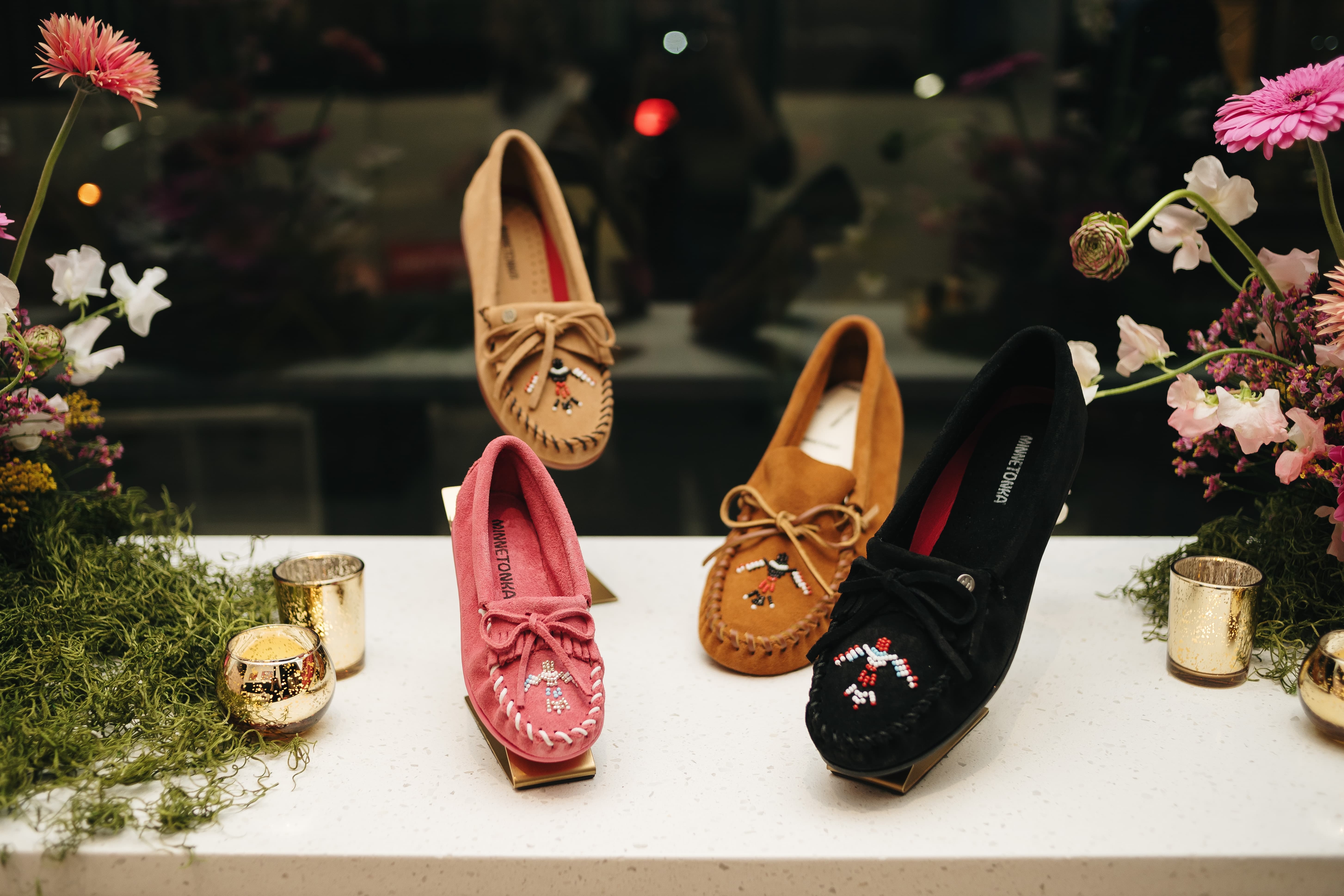

You mentioned before that you find a lot of inspiration through researching your culture’s history and design in historical archives. Can you walk us through how you found your inspiration for the Thunderbird "Animikii" design?
In my designs, I incorporate historical interpretations and teachings passed down through generations, keeping the traditions of my people alive and vibrant.
I wait for a vision to inspire me before starting my creative process – often visualizing it internally, typically after deep reflection and studying imagery and inspiration around me. Then through sketching and digital illustration, I bring the design to life with strokes, colors, shapes and negative spaces.
When designing the beading for Thunderbird “Animikii,” I researched Thunderbird stories throughout Anishinaabe culture – their presence in art, and natural phenomena like lightning, thunder and storms were core influences in creating the final design.
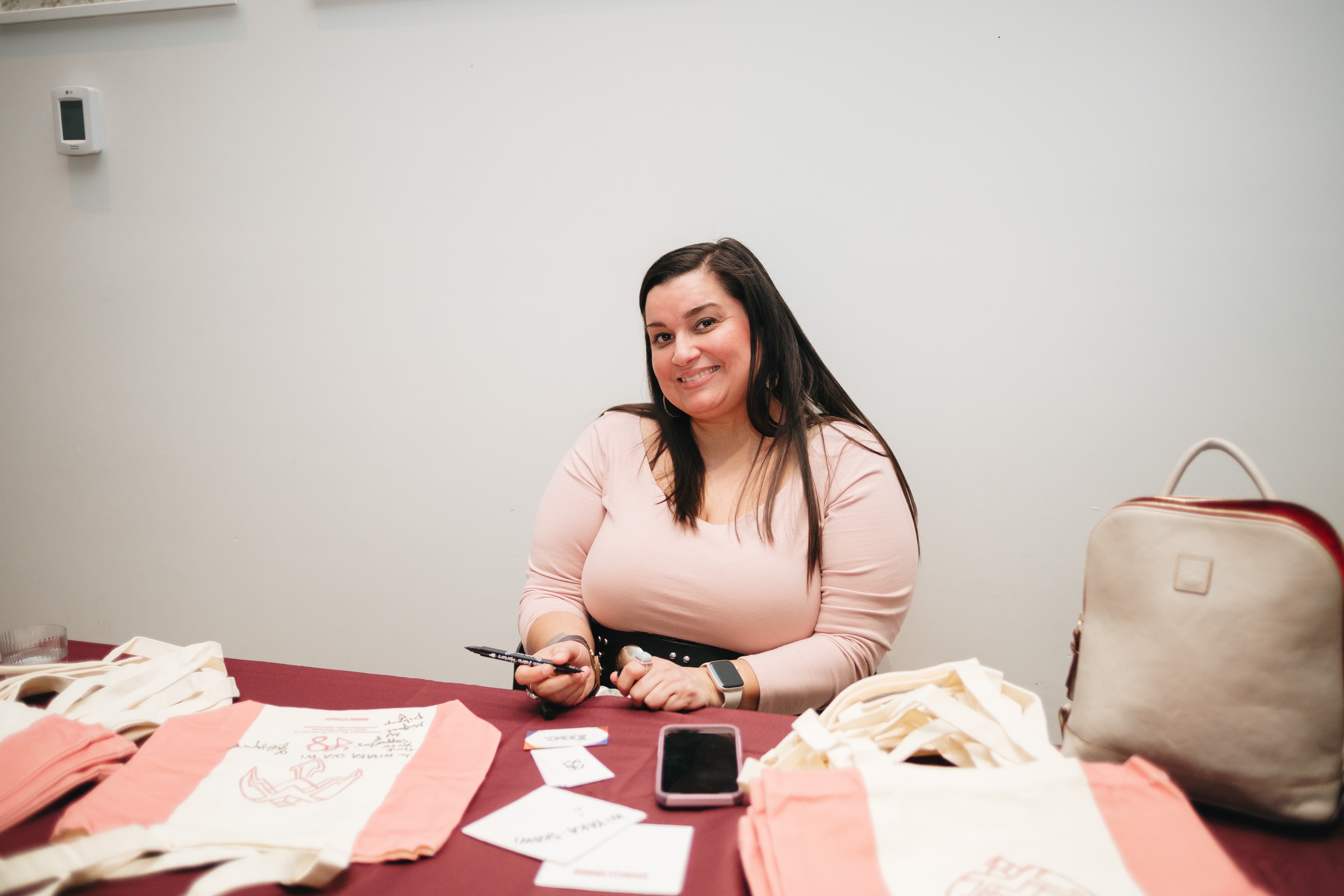

How would you style these shoes? What is your favorite outfit and/or occasion to wear them?
I envision styling these shoes as everyday casual wear, paired with jeans, a tee, and a messy bun. I prefer a low key and low maintenance look. However, if I were to wear them for a community event, I would pair them with my favorite ribbon skirt.
How do you want people to feel while wearing this design?
The desired feeling while wearing this design is one of eagerness and excitement. It should evoke a sense of pride – rocking a fresh design that honors the Anishinaabe way of life, and in a good way.
Where do you see Native American design in the fashion world today? How do you hope to see it in the future?
Indigenous fashion designers are leaving their mark in today’s fashion world through Native American design. Their creations combine cultural heritage and traditional techniques with unique and intricate designs that reflect their lived experiences. By supporting and following Indigenous fashion designers and brands, we can truly appreciate the diversity and creativity of their work. From clothing to accessories, they showcase the richness of Native American artistry, redefining the fashion industry with their unique perspectives.
Indigenous designers are thriving and gaining recognition, as the fashion industry embraces the authenticity of our cultural heritage, craftsmanship, and creativity in a meaningful and impactful way. There is a growing visibility and representation of Native American artists, designers, and creators, with respect to designs being promoted in prominent ways. This progression offers more opportunities for reconciliation, firstly, in the approach of collaboration and partnerships, which can only result in a more inclusive and diverse fashion landscape.


What is something you want Native American designers to know about working with Minnetonka on a collection?
Minnetonka prioritizes a collaborative and respectful approach in the collections we create and design. In that process, and alongside Minnetonka, Adrienne Benjamin centers the perspective of the artists while striving to approach the work in a way that upholds, strengthens, and honors Indigenous values and traditions with reconciliation at the forefront. My commitment is to share my story while respecting our teachings, through the designs I offer to the world. I proudly embrace my Anishinaabe heritage and showcase our creativity by creating designs that honor our people and cultural traditions.
To learn more about Minnetonka’s commitment to the Native American community, please visit this link.
To learn more about Lucie Skjefte, please visit her website.
